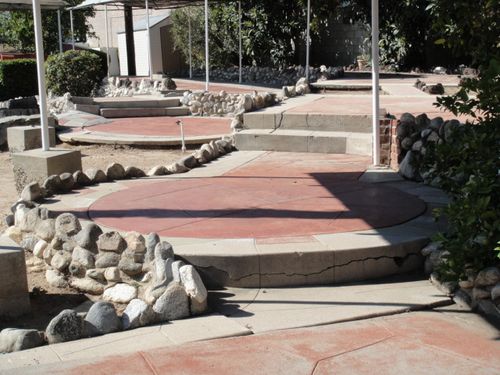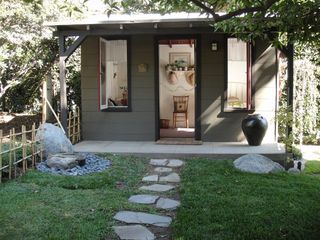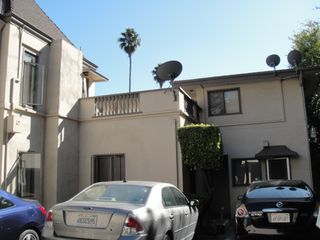
The red concrete path behind Lifeline Fellowship Christian Church covers what used to be the greens of a 1930's mini-golf course.
by Laura Berthold Monteros
Who knew that Altadena used to have its very own miniature golf course? The golf course only operated for two years, 1930-1932, but remnants of it still exist on the property of Lifeline Fellowship Christian Church on Lake and can be seen by peeking over the fence from the alley behind. The greens are filled in with red concrete, but some features are still standing.
Who is responsible for the deep culverts that line so many of Altadena’s north-south streets? Originally called zanjas, the Spanish word for ditch, they were designed by Yorkshireman Francis Beckwith and built by Chinese laborers in the late 1880s, using an English technique of fitting stones without grout or cement.
These were among the delightful discoveries on the Altadena Historical Society tour of Mariposa Street east of Lake on Sunday, Oct. 23. Nine historical sites were featured, most of them family homes built between 1905 and 1924.
Who is responsible for the deep culverts that line so many of Altadena’s north-south streets? Originally called zanjas, the Spanish word for ditch, they were designed by Yorkshireman Francis Beckwith and built by Chinese laborers in the late 1880s, using an English technique of fitting stones without grout or cement.
These were among the delightful discoveries on the Altadena Historical Society tour of Mariposa Street east of Lake on Sunday, Oct. 23. Nine historical sites were featured, most of them family homes built between 1905 and 1924.
Beckwith kept a small dairy a bit to the north on Maiden Lane until his death in 1923. That the ditches still efficiently move the water from gullywashers down the hillside is a tribute to both the designer and the workers.
Altadena (Green) and Mariposa
Long before ADA compliance codes were written, architect Elmer Grey designed “Thatch Cottage” for Effie Neustadt, mother-in-law of Altadena Green. Since Mrs. Neustadt was an invalid confined to a wheelchair, the 1911 house was built to be accessible for her. Residents told Altadena Historical Society that one can go in a circle around the entire upstairs.
The living room ran the entire depth of the house, front to back, so she could easily move from front window views of the mountains to back window views of the sea. The view from the street was important as well, because the house sits below street level and only the roofline is visible from Mariposa. Alternating thick and thin shingles (now replaced) simulated the thatching on an English cottage.
 The Chamberlain house to the west is classic Craftsman, with built-in cabinets, dark wood on the walls, a butler’s pantry and maid’s quarters. It, along with Sarah Noble Ives’ cottage, was open for walkthroughs.
The Chamberlain house to the west is classic Craftsman, with built-in cabinets, dark wood on the walls, a butler’s pantry and maid’s quarters. It, along with Sarah Noble Ives’ cottage, was open for walkthroughs.
Pictured: the playhouse behind the Chamberlain house.
The current owners have furnished the house with mission-style furniture, but have consulted the extensive inventory of furnishings in Mr. Chamberlain’s will for some pieces. In an upstairs bedroom, a dress owned by Mrs. Chamberlain and the box it came in lie on the bed. A “speaking tube” that connects the upstairs to the front door was used as a marble chute by the children of the previous owners, making a commotion that startled their parents. A playhouse on the property still stands; the windows were repurposed as doors for the bookcase in the living room.
The kidnapping that wasn't
In 1933, a scandalous crime occurred on Mariposa when a would-be kidnapper demanded money not to kidnap the sons of Fred and Maziebelle Markham. The Markhams lived in the home Altadena Green and her husband Robert Neustadt had built in 1908 and abandoned when their marriage crumbled. The chief suspect was neighbor Frank Sutton, who was later convicted of the crime.
The Markham estate has been turned into Sahag Mesrob Armenian Christian School, and the more modest Sutton home, designed by Wallace Neff in 1923, was thought to have been demolished and replaced in 1955 by rows of apartment buildings climbing up the hill.
 But herein is another discovery: The house is still intact behind the first apartment building, connected by an upstairs terrace. The house itself is now home to four separate apartments and is hardly recognizable.
But herein is another discovery: The house is still intact behind the first apartment building, connected by an upstairs terrace. The house itself is now home to four separate apartments and is hardly recognizable.
The current owners have furnished the house with mission-style furniture, but have consulted the extensive inventory of furnishings in Mr. Chamberlain’s will for some pieces. In an upstairs bedroom, a dress owned by Mrs. Chamberlain and the box it came in lie on the bed. A “speaking tube” that connects the upstairs to the front door was used as a marble chute by the children of the previous owners, making a commotion that startled their parents. A playhouse on the property still stands; the windows were repurposed as doors for the bookcase in the living room.
The kidnapping that wasn't
In 1933, a scandalous crime occurred on Mariposa when a would-be kidnapper demanded money not to kidnap the sons of Fred and Maziebelle Markham. The Markhams lived in the home Altadena Green and her husband Robert Neustadt had built in 1908 and abandoned when their marriage crumbled. The chief suspect was neighbor Frank Sutton, who was later convicted of the crime.
The Markham estate has been turned into Sahag Mesrob Armenian Christian School, and the more modest Sutton home, designed by Wallace Neff in 1923, was thought to have been demolished and replaced in 1955 by rows of apartment buildings climbing up the hill.
 But herein is another discovery: The house is still intact behind the first apartment building, connected by an upstairs terrace. The house itself is now home to four separate apartments and is hardly recognizable.
But herein is another discovery: The house is still intact behind the first apartment building, connected by an upstairs terrace. The house itself is now home to four separate apartments and is hardly recognizable.Pictured: the terrace connects the apartment houses with Wallace Neff's original Sutton home.
Neighbors who got along much better than the Markhams and Suttons were the four Ives sisters who purchased two adjacent lots on the southeast corner of Mariposa and Maiden Lane in 1924. Sarah Noble Ives, a well-known artist, illustrator, and writer, built a cozy Georgian-style cottage for her retirement. Her three sisters moved into the 1905 Serrurier house next door, which had been moved from across the street in 1910.
For Altadenans, Sarah’s greatest distinction is being Altadena’s first historian. She was in her 70s when the president and founder of Altadena Historical Society Mrs. Frederick Marsh asked her to compile a history of the town. She went door-to-door, canvassing residents and putting together a book that sold about 200 copies.
Docents from Altadena Historical Society gave talks at each of the homes. Other sites on the walking tour were the first fire station, now Studio 918 on the southeast corner of Lake and Altadena; the buildings between Mariposa and Marcheta on (Security National Bank, Webster’s Pharmacy, and the post office); JR Coffee Shop (now El Patron); and the Altadena Business District on Mariposa between El Molino and Lake.
Neighbors who got along much better than the Markhams and Suttons were the four Ives sisters who purchased two adjacent lots on the southeast corner of Mariposa and Maiden Lane in 1924. Sarah Noble Ives, a well-known artist, illustrator, and writer, built a cozy Georgian-style cottage for her retirement. Her three sisters moved into the 1905 Serrurier house next door, which had been moved from across the street in 1910.
For Altadenans, Sarah’s greatest distinction is being Altadena’s first historian. She was in her 70s when the president and founder of Altadena Historical Society Mrs. Frederick Marsh asked her to compile a history of the town. She went door-to-door, canvassing residents and putting together a book that sold about 200 copies.
Docents from Altadena Historical Society gave talks at each of the homes. Other sites on the walking tour were the first fire station, now Studio 918 on the southeast corner of Lake and Altadena; the buildings between Mariposa and Marcheta on (Security National Bank, Webster’s Pharmacy, and the post office); JR Coffee Shop (now El Patron); and the Altadena Business District on Mariposa between El Molino and Lake.
-----
Laura Berthhold Monteros writes about Altadena.



